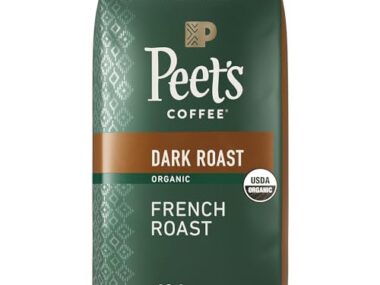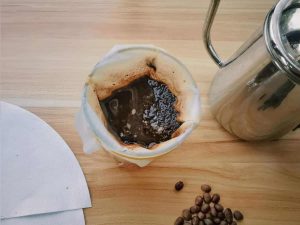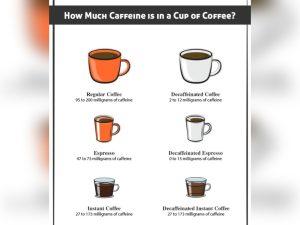If you’ve ever wondered how to make pour over coffee that tastes like it came from your favorite café, you’re in the right place. This simple brewing method puts you in full control of your cup, letting you unlock rich flavors and aromas that instant coffee just can’t match.
Whether you’re new to coffee or looking to perfect your technique, this guide will walk you through each step with clear, easy instructions. By the end, you’ll know exactly how to brew a smooth, balanced cup of pour over coffee that’s tailor-made for your taste.
Ready to elevate your coffee game? Let’s get started!

Credit: www.oxo.com
Equipment Essentials
Making pour over coffee starts with having the right tools. Proper equipment helps you control brewing time, water flow, and flavor extraction. Good gear brings out the best taste in your coffee. Each item plays a key role in the process. Understanding these essentials makes brewing easier and more enjoyable.
Pour Over Dripper Types
Several dripper shapes affect coffee flavor and flow. Cone-shaped drippers focus water through the grounds for a rich taste. Flat-bottom drippers allow water to spread evenly for a balanced cup. Materials like ceramic, glass, or plastic influence heat retention. Choose a dripper that suits your style and budget. Size also matters; single-cup drippers work for solo brews, while larger ones fit multiple cups.
Choosing The Right Filter
Filters control how coffee oils and sediment pass through. Paper filters offer clean, crisp flavors by trapping oils. They are disposable and easy to use. Cloth filters keep some oils and add body but need regular cleaning. Metal filters allow all oils through, giving a fuller taste but more sediment. Match the filter to your dripper and flavor preference. Rinse paper filters before brewing to remove paper taste.
Grinder And Kettle Selection
Grinding fresh coffee beans is crucial for good flavor. Burr grinders produce consistent grind sizes, essential for pour over. Avoid blade grinders, which create uneven grounds. The grind size affects extraction; medium-fine is ideal for pour over. A gooseneck kettle helps control water flow precisely. It allows slow, steady pouring in a circular motion. Temperature control kettles ensure water stays between 195°F and 205°F, perfect for brewing.
Coffee Beans And Grind
The quality of your pour over coffee depends greatly on the coffee beans and grind. These two factors influence the flavor, aroma, and strength of your brew. Choosing the right beans and grinding them correctly ensures a balanced and tasty cup every time.
Fresh, well-ground coffee delivers the best results. Paying attention to bean selection and grind size helps control the extraction process. Measuring the coffee amount accurately also plays a key role in crafting the perfect pour over.
Bean Selection Tips
Select beans that suit your taste preference. Light roast beans offer bright, fruity flavors. Medium roasts provide a balanced and smooth profile. Dark roasts create bold and rich coffee. Choose freshly roasted beans for maximum freshness. Whole beans stay fresh longer than pre-ground coffee. Store beans in an airtight container away from light and heat.
Grind Size For Pour Over
Grind size affects how water flows through the coffee. Use a medium-fine grind for pour over brewing. It resembles the texture of granulated sugar. Too fine a grind causes over-extraction and bitterness. Too coarse a grind leads to under-extraction and weak coffee. Use a burr grinder for consistent particle size. Adjust the grind slightly to match your taste and brewing time.
Measuring Coffee Amount
Accurate measurement ensures consistent flavor. Use a kitchen scale to weigh your coffee beans. A common ratio is 1 gram of coffee to 15-17 grams of water. For a single cup, 15-20 grams of coffee works well. Weigh coffee before grinding for best results. This control helps avoid too strong or too weak coffee. Adjust the amount to fit your taste preferences.
Water Preparation
Water preparation plays a vital role in making a perfect pour over coffee. The water you use affects taste, extraction, and aroma. Precise control over water temperature, quality, and the coffee-to-water ratio ensures a balanced cup. Below are key points to prepare your water for the best brew.
Ideal Water Temperature
Heat water to between 195°F and 205°F (90°C to 96°C). This range extracts coffee flavors properly without burning the grounds. Water that is too hot makes coffee bitter. Too cool water results in weak, under-extracted coffee. Use a thermometer or electric kettle with temperature control for accuracy.
Water Quality Importance
Use clean, fresh water free from odors or minerals. Tap water with strong chlorine or impurities can spoil coffee taste. Filtered or bottled water works best. Avoid distilled or softened water as they lack minerals needed for good extraction. Good water quality brings out coffee’s natural flavors and aromas.
Coffee To Water Ratio
Maintain a ratio of about 1:15 to 1:17 coffee to water by weight. For example, use 20 grams of coffee with 300 ml of water. This ratio balances strength and flavor. Adjust slightly based on personal taste. Too much water makes coffee weak; too little makes it strong and bitter. Use a scale for precise measurement every time.
Brewing Setup
Setting up your brewing station is the first step to making great pour over coffee. A clean and warm setup helps extract the best flavors from your coffee beans. Proper preparation avoids bitter or weak coffee and makes the process smooth.
Focus on three key parts: rinsing the filter, preheating the equipment, and placing the dripper correctly. Each step ensures your coffee brews evenly and tastes fresh.
Rinsing The Filter
Place a paper filter inside the dripper. Pour hot water over it to rinse away paper taste. This step also warms the dripper and carafe. Discard the rinse water before adding coffee grounds.
Preheating The Equipment
Pour hot water into the dripper and carafe to warm them up. This keeps the brewing temperature steady. A stable temperature helps coffee extract evenly. Empty the water before starting your brew.
Setting Up The Dripper
Place the dripper on top of your coffee cup or carafe. Make sure it fits securely and sits level. Add the rinsed filter and your ground coffee. Gently shake to level the coffee bed for an even brew.
Pouring Technique
The pouring technique shapes the flavor of your pour over coffee. It controls extraction and balance. Pouring water correctly helps release the coffee’s aroma and taste. Each step in pouring matters to get the best cup. Focus on the flow and timing of water over the grounds. This section explains the key pouring steps to follow.
Initial Bloom Pour
Start by pouring a small amount of hot water on the coffee grounds. Use about twice the weight of the coffee in water. Let the coffee bloom for 30 to 45 seconds. This step releases trapped gases and prepares grounds for even extraction. Pour slowly and gently to avoid disturbing the bed of coffee. The bloom helps unlock fresh flavors.
Circular Pour Pattern
Pour water in a slow, steady circle starting at the center. Move outward in a spiral motion, then back toward the center. Avoid pouring directly on the filter edges to prevent channeling. This pattern wets all the grounds evenly. Even saturation ensures balanced extraction and a smooth taste. Keep your pour controlled and consistent.
Pacing Your Pour
Pour water gradually over the coffee bed, taking time between pours. Pausing allows water to soak through the grounds and extract flavor. Pour in stages rather than all at once. Watch the coffee bed to keep it evenly wet but not flooded. A steady, moderate pace helps avoid over-extraction or bitterness. Control your pour speed for a clean cup.

Credit: www.frenchpresscoffee.com
Brewing Time And Extraction
Brewing time and extraction play key roles in making pour over coffee. These elements control the flavor and strength of your cup. A balanced extraction brings out the best taste from your coffee grounds. Too short or too long brewing time can spoil the flavor. Understanding these factors helps you brew a smooth, rich coffee.
Optimal Brew Time
The ideal brew time for pour over coffee is usually between 2.5 and 4 minutes. This range allows the water to extract the right flavors without bitterness or sourness. Shorter brew times often lead to weak coffee. Longer brew times may cause over-extraction, making the coffee bitter. Timing your brew carefully ensures a well-balanced cup.
Adjusting Grind And Pour
The grind size affects how fast the water flows through the coffee. A medium-fine grind is a good start for pour over. If the water flows too quickly, use a finer grind. If it takes too long to drip, try a coarser grind. Pouring speed also changes extraction. Pour slowly in a steady circular motion to wet all grounds evenly. Adjust grind and pour for the best taste.
Identifying Under Or Over Extraction
Under-extracted coffee tastes sour and weak. It means the water did not pull enough flavor. Over-extracted coffee tastes bitter and harsh. It means the water extracted too much from the grounds. Check your brew’s taste to find the problem. Adjust grind size, brew time, or pouring technique to fix it. A clear, balanced flavor shows perfect extraction.
Serving And Tasting
Serving and tasting your pour over coffee are the final steps that bring your brewing efforts to life. These moments reveal the true character of your coffee and help you understand its flavor profile. Paying attention to details during serving and tasting can enhance your enjoyment and guide future brews.
Removing The Dripper
After the water has fully passed through the coffee grounds, remove the dripper carefully. Lift it straight up to avoid spills. Set it aside on a stable surface. This stops the brewing process and keeps your coffee from becoming bitter.
Serving Suggestions
Pour your coffee into a pre-warmed cup for the best taste. Try it black first to enjoy its natural flavors. Add milk or sugar only if you prefer. Serve alongside light snacks like toast or fruit to complement the coffee’s taste.
Troubleshooting Flavor Issues
If your coffee tastes bitter, the grind may be too fine or water too hot. Sour notes often mean the coffee is under-extracted, possibly due to a coarse grind or short brew time. Adjust grind size and brewing time gradually to find the perfect balance.

Credit: minimalistbaker.com
Advanced Tips
Advanced tips help refine your pour over coffee skills. These steps improve flavor and consistency. Focus on precision and care to enhance every cup.
Experimenting With Ratios
Changing coffee-to-water ratio affects taste. Use more coffee for stronger flavor. Use less for a lighter brew. Try different ratios to find what you like best. Start with a standard 1:16 ratio and adjust.
Using A Scale For Precision
A scale ensures exact measurements. Weigh coffee grounds and water for accuracy. This controls strength and balance in your brew. Precision helps you repeat your favorite recipes. Avoid guessing amounts to improve results.
Cleaning And Maintenance
Clean your dripper and equipment regularly. Old coffee oils can cause bitter flavors. Rinse with hot water after each use. Deep clean weekly with mild detergent. Keep filters fresh and dry before use.
Frequently Asked Questions
How Do You Make Pour Over Coffee At Home?
Place a rinsed paper filter in the dripper. Grind coffee medium-fine. Add grounds, then slowly pour hot water in circles. Let it drip, then serve.
What Is The Ratio For Pour Over Coffee?
Use a coffee-to-water ratio of 1:15 to 1:17. For example, 20 grams of coffee to 300 ml of water. Adjust to taste.
How To Make 12 Oz Of Pour Over Coffee?
Use 20 grams of medium-fine ground coffee. Heat 12 oz (340 ml) of water to 200°F. Rinse the filter, add grounds, and pour water slowly in circles. Brew for 3-4 minutes. Remove dripper and enjoy your fresh 12 oz pour over coffee.
How Much Coffee Do You Put In A Pour Over Coffee Maker?
Use 1 to 2 tablespoons of medium-fine ground coffee per 6 ounces of water for pour over brewing. Adjust to taste.
Conclusion
Pour over coffee lets you enjoy a fresh, rich cup every time. Use clean equipment and fresh beans for best taste. Pour water slowly and evenly to extract flavors well. Adjust grind size if the coffee tastes too bitter or sour.
With practice, you will brew coffee just how you like it. Enjoy the simple pleasure of making coffee by hand.








